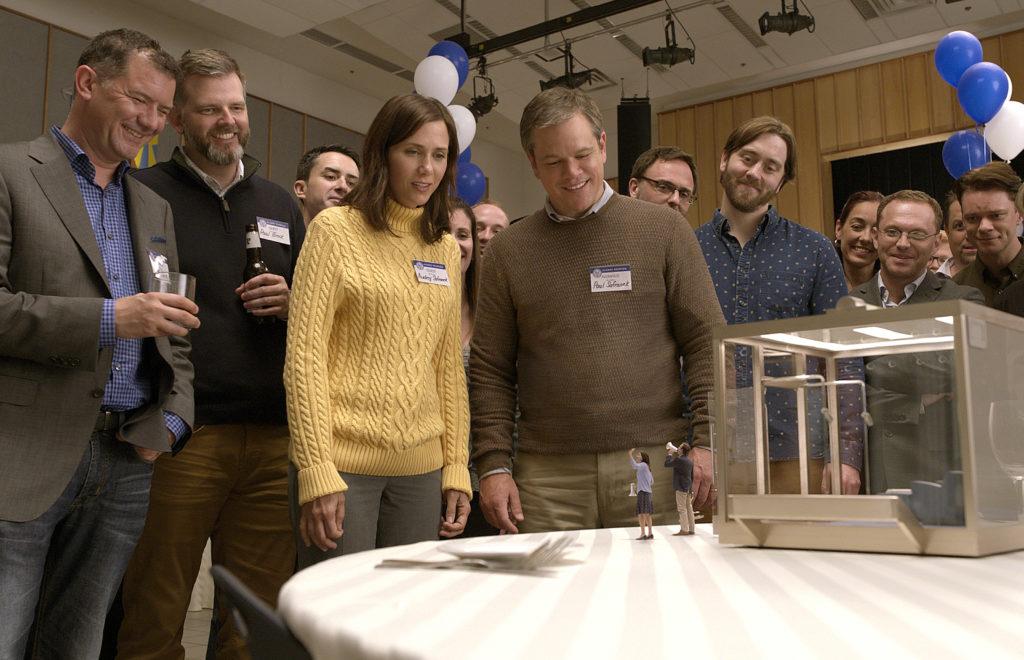
The greatest inventive and scientific achievements of mankind usually pertain to man’s desire to grow beyond this planet. The telescope, sustained flight, manned orbit, and the lunar landings all number among the landmarks of human capability and ingenuity. People often turn to the stars when they imagine the next giant leap for mankind. Downsizing explores the idea that our salvation might come in a much smaller package.
In the near future of Downsizing, Earth is plagued by overpopulation, shortage of resources, climate change, and rampant poverty. To solve this problem, two Norwegian scientists create a process by which they shrink people on a scale of about 224,000 to 1. In doing so, tiny communities that use very few resources and create very little waste begin to spring up across the globe. In a last-ditch attempt to mitigate the negative effects of humanity on this planet, countries are providing huge incentives to Downsizing. Less resource use and less waste are traded for a huge federal tax credit, along with an assets adjustment. A little money as a normal person translates to millions of dollars as a tiny person.
The audience experiences the global phenomenon in a series of time jumps seen through the eyes of Paul Safranek (Matt Damon). Paul lives happily with his wife Audrey (Kristen Wiig), but they struggle to make ends meet with their meager incomes. After the Safraneks meet an old classmate, Dave Johnson (Jason Sudeikis), who underwent the Downsizing procedure, the couple decides to do the same. As the trailer suggests, after Paul goes through with the procedure, he is informed by his wife that she backed out at the last minute. The couple divorces and Paul is left living in Leisure Land, a luxury tiny-person community, alone.
From the start of the movie, through this point to the end of the second act, Downsizing presents itself as a quirky comedy with a important message about the environment. The trailer is full of jokes or “fish out of water” moments, almost every character the audiences sees or meets until the 90-minute mark is either Matt Damon or a comedic actor. Presented in the trailer are Kristen Wiig, Neil Patrick Harris, Jason Sudeikis, and character actress Margo Martindale. The characters played by Christoph Waltz, Udo Kier, and Hong Chau are also used almost exclusively for comedic effect when the audience first meets them. All of these points would be in the movie’s favor if Downsizing didn’t shift tones dramatically at the end of the second act. After playing most scenes for laughs or empathy, Downsizing pivots into a more somber and moralizing film. The message that the movie presents is important and meaningful, but it comes much too late in the film to allow for a smooth progression. Instead, the shift in tone feels forced and abrupt, leaving a sense of disorder that permeates the finale.
Downsizing would come off as a much more cohesive movie without this tonal turn. The movie is very enjoyable, and the concept that Downsizing toys with warrants more exploration than the film provides. Downsizing would be better served by explaining and creating a world in which people can shrink themselves and sticking to comedy, or by beginning as it ends—as a serious science-fiction film with a message. The film is not bad by any means, it simply could have been better. Further, certain scenes that take place later in the film are treated with grave importance, yet there was little or no buildup to them in the earlier parts of the movie. In this way, Downsizing appears as if certain scenes were left on the cutting room floor to account for length and tone.
To its credit, Downsizing is a brilliantly acted and directed film. Alexander Payne’s masterful touch is present in this movie, just as it is in his earlier films like Sideways and Nebraska. Matt Damon and the other side characters are engaging and vibrant. Hong Chau, in her role as Ngoc Lan Tran, is absolutely magnetic. She steals every scene she appears in, and when she is off-screen, audiences are left pining for her return. Unfortunately, her performance cannot make up for the narrative faults, and Downsizing is left dreaming too big in spite of its tiny stature.
Featured Image by Paramount Pictures



















